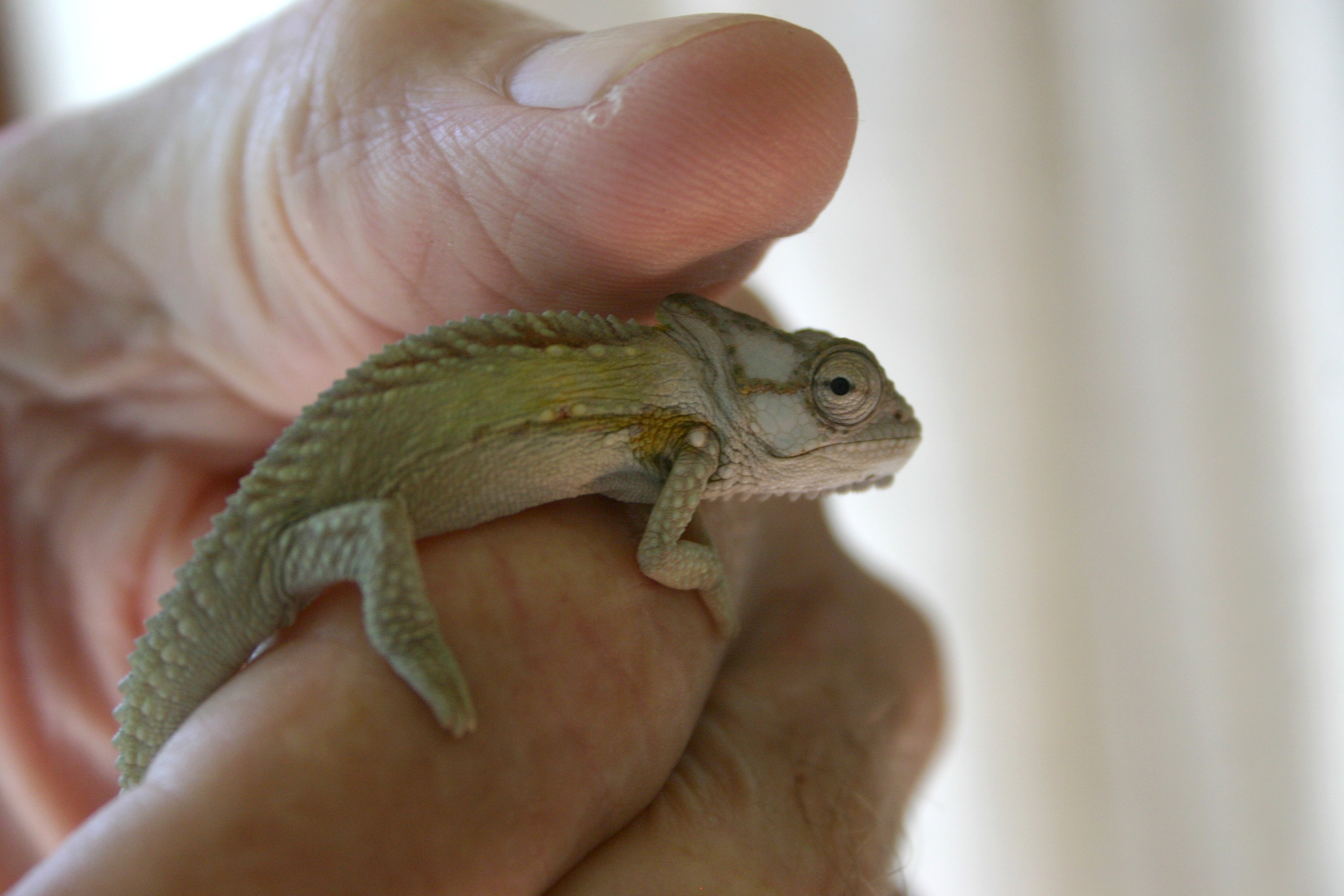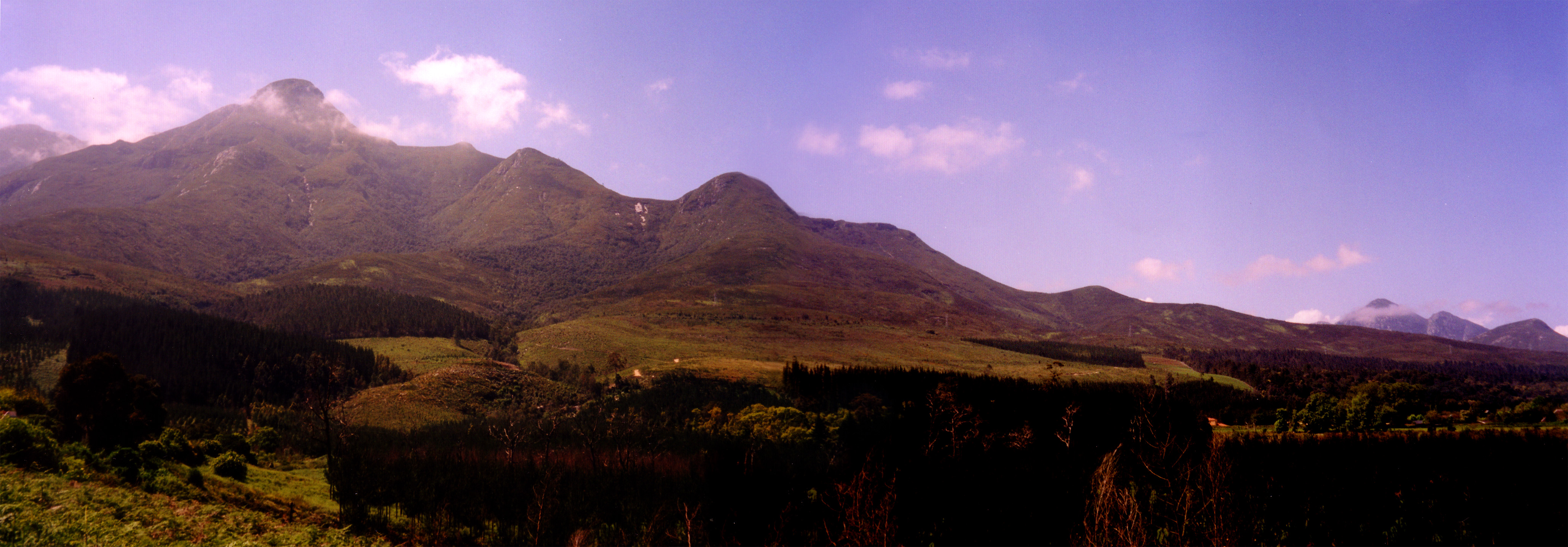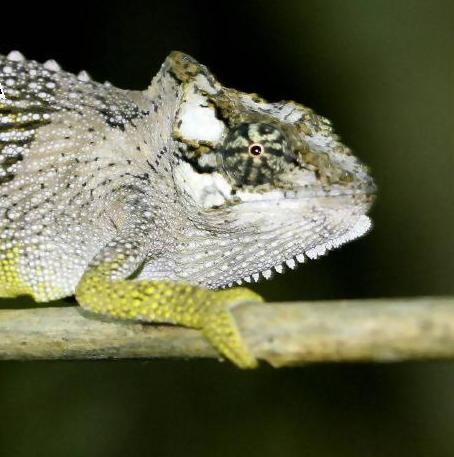|
Knysna Dwarf Chameleon
The Knysna dwarf chameleon (''Bradypodion damaranum'') is a species of dwarf chameleon in the ''Bradypodion'' ("slow footed") genus that is endemic to South Africa. It is a forest dweller, found only in a limited range in the afromontane forests near Knysna, South Africa, and in certain surrounding areas. Description This species has the longest tail of all the ''Bradypodion'' species. As with most chameleons, its tongue is twice the length of its body and it can be shot out of its mouth using a special muscle in the jaw. This gives the chameleon the ability to catch insects some distance away. The Knysna dwarf chameleon has a prominent casque and has bright green to bluish skin, decorated with purple, yellow and pink hues. It is up to total length. Taxonomy In the past, most South African dwarf chameleons were considered to be a subspecies of one Cape ''Bradypodion'' species This is now known to be wrong, however; ''B. damaranum'' does not appear to have any particularly close ... [...More Info...] [...Related Items...] OR: [Wikipedia] [Google] [Baidu] |
George Albert Boulenger
George Albert Boulenger (19 October 1858 – 23 November 1937) was a Belgian-British zoologist who described and gave scientific names to over 2,000 new animal species, chiefly fish, reptiles, and amphibians. Boulenger was also an active botanist during the last 30 years of his life, especially in the study of roses. Life Boulenger was born in Brussels, Belgium, the only son of Gustave Boulenger, a Belgian public notary, and Juliette Piérart, from Valenciennes. He graduated in 1876 from the Free University of Brussels with a degree in natural sciences, and worked for a while at the Royal Belgian Institute of Natural Sciences, Brussels, as an assistant naturalist studying amphibians, reptiles, and fishes. He also made frequent visits during this time to the ''Muséum national d'Histoire naturelle'' in Paris and the British Museum in London. In 1880, he was invited to work at the Natural History Museum, then a department of the British Museum, by Dr. Albert C. L. G. Günther a ... [...More Info...] [...Related Items...] OR: [Wikipedia] [Google] [Baidu] |
Species
In biology, a species is the basic unit of classification and a taxonomic rank of an organism, as well as a unit of biodiversity. A species is often defined as the largest group of organisms in which any two individuals of the appropriate sexes or mating types can produce fertile offspring, typically by sexual reproduction. Other ways of defining species include their karyotype, DNA sequence, morphology, behaviour or ecological niche. In addition, paleontologists use the concept of the chronospecies since fossil reproduction cannot be examined. The most recent rigorous estimate for the total number of species of eukaryotes is between 8 and 8.7 million. However, only about 14% of these had been described by 2011. All species (except viruses) are given a two-part name, a "binomial". The first part of a binomial is the genus to which the species belongs. The second part is called the specific name or the specific epithet (in botanical nomenclature, also sometimes i ... [...More Info...] [...Related Items...] OR: [Wikipedia] [Google] [Baidu] |
Reptiles Of South Africa
Reptiles, as most commonly defined are the animals in the class Reptilia ( ), a paraphyletic grouping comprising all sauropsids except birds. Living reptiles comprise turtles, crocodilians, squamates (lizards and snakes) and rhynchocephalians (tuatara). As of March 2022, the Reptile Database includes about 11,700 species. In the traditional Linnaean classification system, birds are considered a separate class to reptiles. However, crocodilians are more closely related to birds than they are to other living reptiles, and so modern cladistic classification systems include birds within Reptilia, redefining the term as a clade. Other cladistic definitions abandon the term reptile altogether in favor of the clade Sauropsida, which refers to all amniotes more closely related to modern reptiles than to mammals. The study of the traditional reptile orders, historically combined with that of modern amphibians, is called herpetology. The earliest known proto-reptiles originated around 31 ... [...More Info...] [...Related Items...] OR: [Wikipedia] [Google] [Baidu] |
Eastern Cape
The Eastern Cape is one of the provinces of South Africa. Its capital is Bhisho, but its two largest cities are East London and Gqeberha. The second largest province in the country (at 168,966 km2) after Northern Cape, it was formed in 1994 out of the Xhosa homelands or bantustans of Transkei and Ciskei, together with the eastern portion of the Cape Province. The central and eastern part of the province is the traditional home of the indigenous Xhosa people. In 1820 this area which was known as the Xhosa Kingdom began to be settled by Europeans who originally came from England and some from Scotland and Ireland. Since South Africa's early years, many Xhosas believed in Africanism and figures such as Walter Rubusana believed that the rights of Xhosa people and Africans in general, could not be protected unless Africans mobilized and worked together. As a result, the Eastern Cape is home to many anti-apartheid leaders such as Robert Sobukwe, Oliver Tambo, Nelson Mandel ... [...More Info...] [...Related Items...] OR: [Wikipedia] [Google] [Baidu] |
Western Cape
The Western Cape is a province of South Africa, situated on the south-western coast of the country. It is the fourth largest of the nine provinces with an area of , and the third most populous, with an estimated 7 million inhabitants in 2020. About two-thirds of these inhabitants live in the metropolitan area of Cape Town, which is also the provincial capital. The Western Cape was created in 1994 from part of the former Cape Province. The two largest cities are Cape Town and George. Geography The Western Cape Province is roughly L-shaped, extending north and east from the Cape of Good Hope, in the southwestern corner of South Africa. It stretches about northwards along the Atlantic coast and about eastwards along the South African south coast (Southern Indian Ocean). It is bordered on the north by the Northern Cape and on the east by the Eastern Cape. The total land area of the province is , about 10.6% of the country's total. It is roughly the size of England or the S ... [...More Info...] [...Related Items...] OR: [Wikipedia] [Google] [Baidu] |
Tsitsikamma
The Tsitsikamma National Park is a protected area on the Garden Route, Western Cape and Eastern Cape, South Africa. It is a coastal reserve well known for its indigenous forests, dramatic coastline, and the Otter Trail. On 6 March 2009 it was amalgamated with the Wilderness National Park and various other areas of land to form the Garden Route National Park. The park covers an long stretch of coastline. Nature's Valley is at the western end of the park, and the main accommodation is at Storms River Mouth. Near the park is the Bloukrans Bridge, the world's highest bridge bungee jump at . The word "Tsitsikamma" originates from the Khoekhoe language ''tse-tsesa'', meaning "clear", and ''gami'', meaning "water", probably referring to the clear water of the Tsitsikamma River. Other meanings are 'place of much water' and 'waters begin'. Camps Storms River Various amenities, including a restaurant, shop, chalets, campsite and caravan park, information centre, adventure boo ... [...More Info...] [...Related Items...] OR: [Wikipedia] [Google] [Baidu] |
Outeniqua Mountains
The Outeniqua Mountains, named after the Outeniqua Khoikhoi who lived there, is a mountain range that runs a parallel to the southern coast of South Africa, and forms a continuous range with the Langeberg to the west and the Tsitsikamma Mountains to the east. It was known as ''Serra de Estrella'' (Mountain of the Star) to the Portuguese. The mountains are part of the Garden Route of South Africa. Nomenclature "Outeniqua" is said to be derived from a Khoikhoi tribe that once lived in the mountains, and means "they who bear honey". Indigenous rock paintings can still be found in the area. History The region was first explored by white settlers in 1668 and in 1782, French explorer and ornithologist François Levaillant explored the area and discovered farmers had settled at foot of the mountain range. Historic incidents On 1 June 2002, former South Africa cricket captain Hansie Cronje's scheduled flight home from Johannesburg to George, Western Cape was grounded so he hitched a ride ... [...More Info...] [...Related Items...] OR: [Wikipedia] [Google] [Baidu] |
Bradypodion Damaranum Submissive
''Bradypodion'' (meaning "slow-footed" in Greek) is one of six genera of chameleons within the "true" or "typical" chameleons (Family Chamaeleonidae). They are native to southern Africa, and are sometimes collectively called South African dwarf chameleons. Some other small chameleons from eastern and central Africa are occasionally placed herein, but this is probably in error and not followed here. See also Systematics below and ''Kinyongia'' and ''Nadzikambia''. __TOC__ Species 20 species are currently recognized: Undescribed species * Emerald dwarf chameleon, ''Bradypodion'' sp. (Emerald) * ''Bradypodion'' sp. (Groendal) * ''Bradypodion'' sp. (Grootvadersbosch) * ''Bradypodion'' sp. (Jagersbos) Systematics Delimitation of ''Bradypodion'' has been controversial for some time. Most species seem readily distinguishable by morphological characteristics, but for some time the genus was used as a wastebin taxon for smaller chameleons from sub-Saharan Africa with plesiomorphic he ... [...More Info...] [...Related Items...] OR: [Wikipedia] [Google] [Baidu] |
Basal (biology)
In phylogenetics, basal is the direction of the ''base'' (or root) of a rooted phylogenetic tree or cladogram. The term may be more strictly applied only to nodes adjacent to the root, or more loosely applied to nodes regarded as being close to the root. Note that extant taxa that lie on branches connecting directly to the root are not more closely related to the root than any other extant taxa. While there must always be two or more equally "basal" clades sprouting from the root of every cladogram, those clades may differ widely in taxonomic rank, species diversity, or both. If ''C'' is a basal clade within ''D'' that has the lowest rank of all basal clades within ''D'', ''C'' may be described as ''the'' basal taxon of that rank within ''D''. The concept of a 'key innovation' implies some degree of correlation between evolutionary innovation and diversification. However, such a correlation does not make a given case predicable, so ancestral characters should not be imputed to the ... [...More Info...] [...Related Items...] OR: [Wikipedia] [Google] [Baidu] |
Cape Dwarf Chameleon
The Cape dwarf chameleon (''Bradypodion pumilum'') is a chameleon native to the South African province of the Western Cape, where it is restricted to the region around Cape Town. As with most chameleons, its tongue is twice the length of its body and it can be shot out of its mouth using a special muscle in the jaw. This gives the chameleon the ability to catch insects some distance away. Description The Cape dwarf chameleon grows to over in length, including the tail, with males and females reaching similar adult sizes. They are ovoviviparous, but examination in controlled captivity has shown the very soft egg-like membrane around the young is discarded immediately on birth. The young resemble miniature versions of the adults, with muted colours, and typically reach no more than 2 cm in length at birth. Adults can vary quite significantly in colour variety, saturation and pattern, some appearing much more vibrant than others. Like most chameleons, the tail is prehensile, ... [...More Info...] [...Related Items...] OR: [Wikipedia] [Google] [Baidu] |
Subspecies
In biological classification, subspecies is a rank below species, used for populations that live in different areas and vary in size, shape, or other physical characteristics (morphology), but that can successfully interbreed. Not all species have subspecies, but for those that do there must be at least two. Subspecies is abbreviated subsp. or ssp. and the singular and plural forms are the same ("the subspecies is" or "the subspecies are"). In zoology, under the International Code of Zoological Nomenclature, the subspecies is the only taxonomic rank below that of species that can receive a name. In botany and mycology, under the International Code of Nomenclature for algae, fungi, and plants, other infraspecific ranks, such as variety, may be named. In bacteriology and virology, under standard bacterial nomenclature and virus nomenclature, there are recommendations but not strict requirements for recognizing other important infraspecific ranks. A taxonomist decides whether ... [...More Info...] [...Related Items...] OR: [Wikipedia] [Google] [Baidu] |
Bradypodion Damaranum00
''Bradypodion'' (meaning "slow-footed" in Greek) is one of six genera of chameleons within the "true" or "typical" chameleons (Family Chamaeleonidae). They are native to southern Africa, and are sometimes collectively called South African dwarf chameleons. Some other small chameleons from eastern and central Africa are occasionally placed herein, but this is probably in error and not followed here. See also Systematics below and ''Kinyongia'' and ''Nadzikambia''. __TOC__ Species 20 species are currently recognized: Undescribed species * Emerald dwarf chameleon, ''Bradypodion'' sp. (Emerald) * ''Bradypodion'' sp. (Groendal) * ''Bradypodion'' sp. (Grootvadersbosch) * ''Bradypodion'' sp. (Jagersbos) Systematics Delimitation of ''Bradypodion'' has been controversial for some time. Most species seem readily distinguishable by morphological characteristics, but for some time the genus was used as a wastebin taxon for smaller chameleons from sub-Saharan Africa with plesiomorphic he ... [...More Info...] [...Related Items...] OR: [Wikipedia] [Google] [Baidu] |











